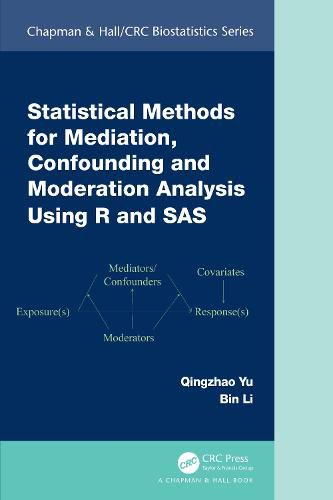Readings Newsletter
Become a Readings Member to make your shopping experience even easier.
Sign in or sign up for free!
You’re not far away from qualifying for FREE standard shipping within Australia
You’ve qualified for FREE standard shipping within Australia
The cart is loading…






Third-variable effect refers to the effect transmitted by third-variables that intervene in the relationship between an exposure and a response variable. Differentiating between the indirect effect of individual factors from multiple third-variables is a constant problem for modern researchers.
Statistical Methods for Mediation, Confounding and Moderation Analysis Using R and SAS introduces general definitions of third-variable effects that are adaptable to all different types of response (categorical or continuous), exposure, or third-variables. Using this method, multiple third- variables of different types can be considered simultaneously, and the indirect effect carried by individual third-variables can be separated from the total effect. Readers of all disciplines familiar with introductory statistics will find this a valuable resource for analysis.
Key Features:
Parametric and nonparametric method in third variable analysis Multivariate and Multiple third-variable effect analysis Multilevel mediation/confounding analysis Third-variable effect analysis with high-dimensional data Moderation/Interaction effect analysis within the third-variable analysis R packages and SAS macros to implement methods proposed in the book
$9.00 standard shipping within Australia
FREE standard shipping within Australia for orders over $100.00
Express & International shipping calculated at checkout
Stock availability can be subject to change without notice. We recommend calling the shop or contacting our online team to check availability of low stock items. Please see our Shopping Online page for more details.
Third-variable effect refers to the effect transmitted by third-variables that intervene in the relationship between an exposure and a response variable. Differentiating between the indirect effect of individual factors from multiple third-variables is a constant problem for modern researchers.
Statistical Methods for Mediation, Confounding and Moderation Analysis Using R and SAS introduces general definitions of third-variable effects that are adaptable to all different types of response (categorical or continuous), exposure, or third-variables. Using this method, multiple third- variables of different types can be considered simultaneously, and the indirect effect carried by individual third-variables can be separated from the total effect. Readers of all disciplines familiar with introductory statistics will find this a valuable resource for analysis.
Key Features:
Parametric and nonparametric method in third variable analysis Multivariate and Multiple third-variable effect analysis Multilevel mediation/confounding analysis Third-variable effect analysis with high-dimensional data Moderation/Interaction effect analysis within the third-variable analysis R packages and SAS macros to implement methods proposed in the book